Sailing with a bpurpose: that’s why I set off from Santa Maria in September 2023 with Blue Alligator towards Guinea-Bissau. Our expedition was to learn more about the plastic waste in the archipelago. Because there is plenty of it there. It floats in the brown current between the 88 islands and is deposited on their beaches, forming a desolate fringe along the tide line and hanging between the roots of the mangroves.
We wanted to clean at least some of the beach sections where the leatherback turtles lay their eggs and the newly hatched baby turtles crawl into the sea. That was the intention. We were the eight boats and their crews that had joined the expedition organised by Portuguese entrepreneur Miguel Teixeira: two Dutch, two Spanish, three Portuguese yachts and me with Blue Alligator.
Cleaning without turtles
On the second day of our stay in Bolama, the former colonial capital, we actually set off on a cleaning mission, albeit far away from the turtle beaches. We found ourselves in a field in front of the governor’s palace. Today, the magnificent colonial building only provides shelter for the goats and dogs in the town. But at least it conveys something of the former opulence with which the Portuguese resided in Guinea-Bissau.
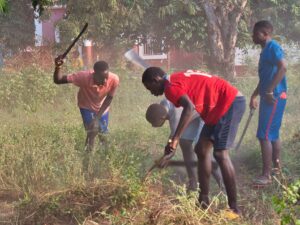
Young people working on field in Bolama.
When we arrived at the site, children and young people were already at work. They were beating bushes and shrubs with machetes and hoes, kicking up a lot of dust. We were supposed to clear the exposed areas of plastic waste. But there wasn’t much.
A role model?
Bolama is a dirty place. Plastic lies in several layers on the sandy streets and in the alleyways between the dilapidated houses. The weed field, however, was the exception to the rule. Of course, there was still enough to fill a bag or two. But there would have been more productive corners in and around Bolama.
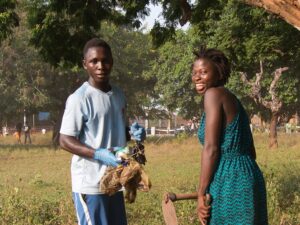
A young couple participating in the cleaning action in Bolama.
I don’t know exactly who came up with the idea of directing our cleaning frenzy there. I suspect the local authorities. They probably thought it was a good idea to combine clearing the field with a clean-up operation – since we were there and eager to do something. Perhaps they also thought we would set a good example for the schoolchildren who were beating up the plants. Undoubtedly, we left a lasting, if rather bizarre, impression as we rummaged for scraps and shreds.
Wrong timing
We didn’t make it to the turtle islands. Somehow the timing wasn’t right. It was never right. No sooner had we landed on the beach and unloaded a few bags of clothes – the humanitarian aspect of our trip – than we were supposed to sail to the next island. Paulo, the anthropologist, therefore left Blue Alligator somewhat frustrated to spend more time with the local people. I could understand him.
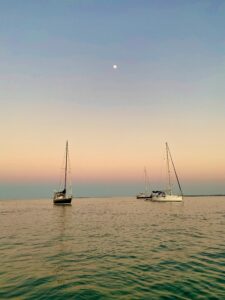
Three of the eight boats of the expedition at anchor at the island of Rubane.
When the fleet was due to sail to Bissau, now the capital of Guinea-Bissau, to meet the Portuguese ambassador and hand over an underwater drone to the people in charge of the nature reserve, four ships left: the two Dutchmen, one of the Portuguese and Blue Alligator. We stayed in the archipelago, sailed up to Rubane Island and got some rest.
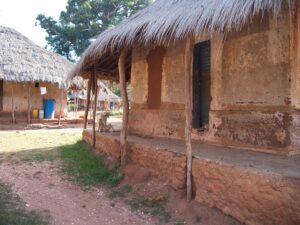
Huts in a village on the island of Roxa.
Time for the villages
We found time to wander into the villages. We met women and girls pounding rice to separate the kernels from the husks. We met young men climbing the palm trees with liana slings to harvest the fruit. Herds of goats and sheep roamed the forests around the villages. These consist of simple mud huts. The roofs are made of thatch. Sometimes mobile phones hang from the beams under the verandas. The electricity comes from small solar cells that bake in the sun on the ground.
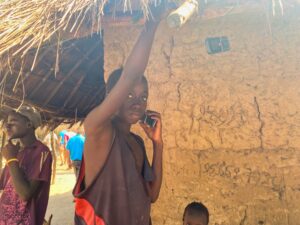
A boy using a mobile phone in his village.
I would also have liked to know more about the traditions that characterise the lives of the islanders. These include, for example, the fact that men around the age of 40 withdraw from the village community for a certain period of time. They live in seclusion and prepare for the next stage of their lives. At least that’s how a young man I met in Bolama explained it. His name was Domingos, and when I asked him whether he himself would take on such a self-imposed exile, he swayed his head thoughtfully. He didn’t know, he said, but wouldn’t rule it out either.
How the turtle got its shell
On one of the evenings when we were sitting in the cockpit of Blue Alligator by the light of a lantern, Paulo told me a beautiful legend from the Bijagós. It was about how turtles got their shells. It goes like this: One day, a turtle got caught up in a ceremony designed to turn young people into adults. It consisted of men beating the candidate with sticks. These blows were now also directed at the turtle.
As it was defenceless – it did not yet have a shell on its back – these blows naturally hurt. However, the young men who were subjected to the hits were wearing bamboo cane armour. The turtle saw this and put on a shell of its own in order to be protected from then on.
On the islands, ceremonies not only regulate the stages of life. They also determine how people interact with nature, such as when oysters can be harvested. This is not done arbitrarily. One year of harvesting is followed by another without. The Bijagós do not need to be taught sustainability.
Strong queens in the past
Gender relations are also much more balanced than on the mainland, for example. And the history of the Bijagós includes strong queens, whose strategies in dealing with the whites ensured their survival and independence during the colonial era. „We respect our women,“ said Domingos, even if they are not queens.
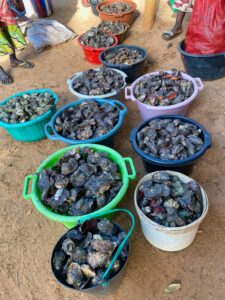
Oysters from the Bijagos.
Unfortunately, I didn’t meet any. Perhaps Paulo will tell me about his encounters when I get back to Santa Maria. In the labyrinth of alleyways, however, we were swarmed by children. The adults, they explained, were working in the fields. We met some of them anyway.
A young woman, her child by the hand, asked for clothes. She was wearing an earth-coloured, holey T-shirt and something black wrapped around her hips like a skirt. One girl asked for pens. But only after she had helped one of us, who had stepped into an ants‘ nest, to get rid of the beasts. Two men sitting on plastic chairs at the entrance to the village wanted medicine. „For what,“ we asked. „Oh, for all kinds of ailments and pains,“ they replied.
We were carrying neither clothes nor pens and certainly no pills. Our charitable cargo had already been distributed: to a hospital in Boubaque, to two parishes in Bolama and to a village on the island of Roxa.
Adelino Da Costa, the boxing champion and tourism entrepreneur, told me that we would have been better off not bringing anything at all. The next people to come after us would be expected to do the same or even more. But that doesn’t correspond to his idea of how to help the Bijagós and the people there.
Our actual role
But otherwise Da Costa was quite happy about our presence, because we would act as a kind of ambassador to publicise the Bijagós as a travel and, above all, sailing destination. So that was our mission. Not everyone was happy about the role we had been given.
After all, we were something like pioneers. But I’ll write about what it’s really like to sail in the Bijagós and return to Mindelo in the next blog post.
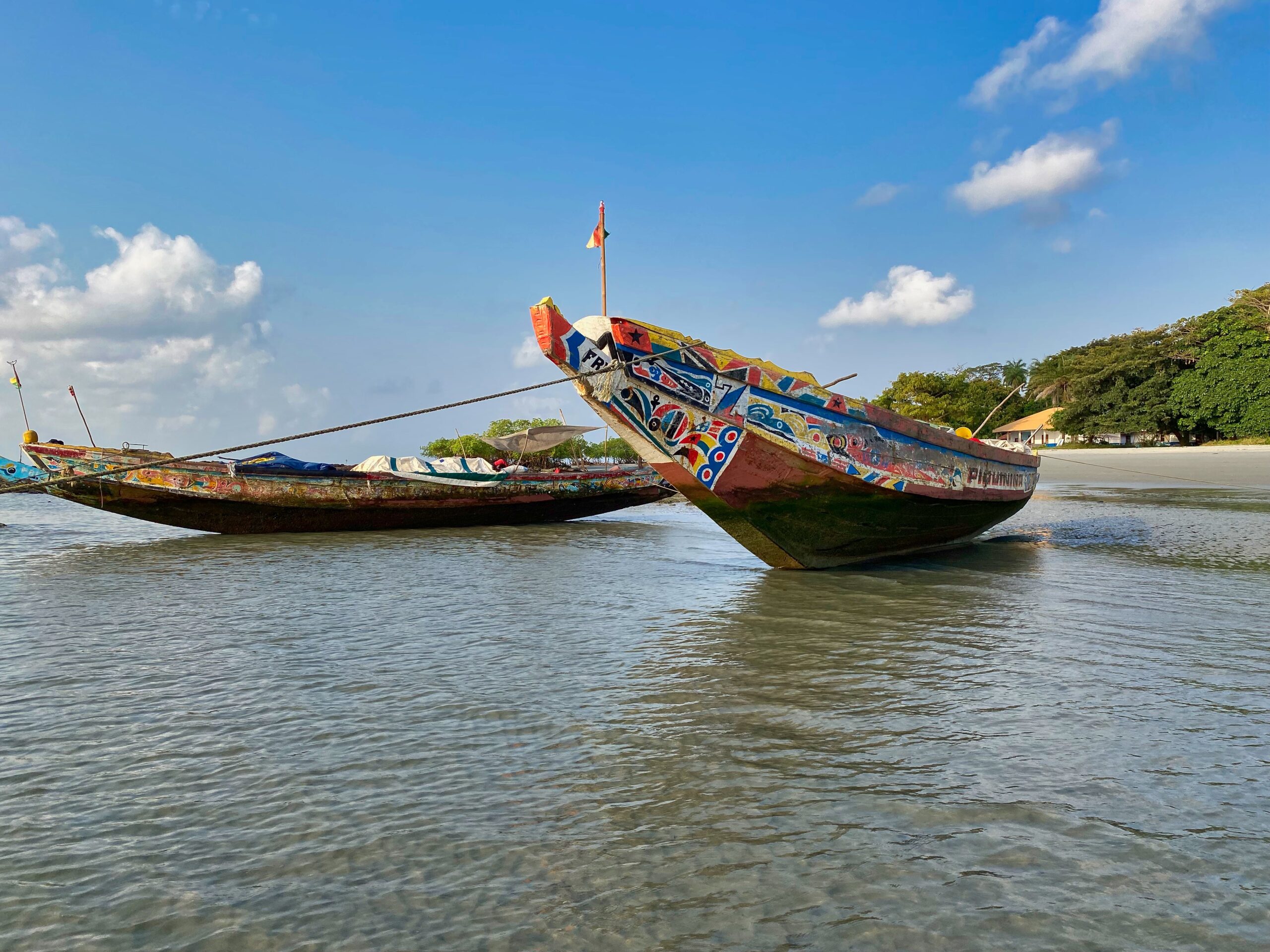
Pingback: Tourismus anstatt Plastik - Meergeschichten
Thank you Rony